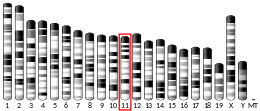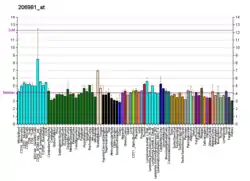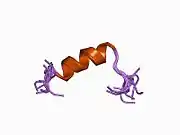Nav1.4
Nav1.4 که با نامِ کانال سدیم نوع ۴، زیرواحد آلفا (انگلیسی: Sodium channel protein type 4 subunit alpha) هم شناخته میشود، یک پروتئین است که در انسان توسط ژن «SCN4A» کُدگذاری میشود.[4][5][6][7]
اهمیت بالینی
این مجرا، نوعی کانال یونی با درگاه وابستهبه ولتاژ است که جهش در آن، با بروز اختلالاتی نظیر «فلج دورهای هیپوکالمیک»، «فلج دورهای هیپرکالمیک» و «پارامیوتونی مادرزادی» و «میوتونی بدترشونده با پتاسیم» در ارتباط است.
منابع
- GRCm38: Ensembl release 89: ENSMUSG00000001027 - Ensembl, May 2017
- "Human PubMed Reference:". National Center for Biotechnology Information, U.S. National Library of Medicine.
- "Mouse PubMed Reference:". National Center for Biotechnology Information, U.S. National Library of Medicine.
- Ptacek LJ, Trimmer JS, Agnew WS, Roberts JW, Petajan JH, Leppert M (Oct 1991). "Paramyotonia congenita and hyperkalemic periodic paralysis map to the same sodium-channel gene locus". Am J Hum Genet. 49 (4): 851–4. PMC 1683172. PMID 1654742.
- Ptacek LJ, George AL Jr, Griggs RC, Tawil R, Kallen RG, Barchi RL, Robertson M, Leppert MF (Jan 1992). "Identification of a mutation in the gene causing hyperkalemic periodic paralysis". Cell. 67 (5): 1021–7. doi:10.1016/0092-8674(91)90374-8. PMID 1659948.
- Catterall WA, Goldin AL, Waxman SG (Dec 2005). "International Union of Pharmacology. XLVII. Nomenclature and structure-function relationships of voltage-gated sodium channels". Pharmacol Rev. 57 (4): 397–409. doi:10.1124/pr.57.4.4. PMID 16382098.
- "Entrez Gene: SCN4A sodium channel, voltage-gated, type IV, alpha subunit".
- مشارکتکنندگان ویکیپدیا. «Nav1.4». در دانشنامهٔ ویکیپدیای انگلیسی، بازبینیشده در ۷ ژوئن ۲۰۱۸.
بیشتر بخوانید
- Ackerman MJ, Clapham DE (1997). "Ion channels--basic science and clinical disease". N. Engl. J. Med. 336 (22): 1575–86. doi:10.1056/NEJM199705293362207. PMID 9164815.
- Wang JZ, Rojas CV, Zhou JH, et al. (1992). "Sequence and genomic structure of the human adult skeletal muscle sodium channel alpha subunit gene on 17q". Biochem. Biophys. Res. Commun. 182 (2): 794–801. doi:10.1016/0006-291X(92)91802-W. PMID 1310396.
- Ptacek LJ, Tawil R, Griggs RC, et al. (1992). "Linkage of atypical myotonia congenita to a sodium channel locus". Neurology. 42 (2): 431–3. doi:10.1212/wnl.42.2.431. PMID 1310531.
- McClatchey AI, Van den Bergh P, Pericak-Vance MA, et al. (1992). "Temperature-sensitive mutations in the III-IV cytoplasmic loop region of the skeletal muscle sodium channel gene in paramyotonia congenita". Cell. 68 (4): 769–74. doi:10.1016/0092-8674(92)90151-2. PMID 1310898.
- George AL, Komisarof J, Kallen RG, Barchi RL (1992). "Primary structure of the adult human skeletal muscle voltage-dependent sodium channel". Ann. Neurol. 31 (2): 131–7. doi:10.1002/ana.410310203. PMID 1315496.
- Ptácek LJ, George AL, Barchi RL, et al. (1992). "Mutations in an S4 segment of the adult skeletal muscle sodium channel cause paramyotonia congenita". Neuron. 8 (5): 891–7. doi:10.1016/0896-6273(92)90203-P. PMID 1316765.
- McClatchey AI, McKenna-Yasek D, Cros D, et al. (1993). "Novel mutations in families with unusual and variable disorders of the skeletal muscle sodium channel". Nat. Genet. 2 (2): 148–52. doi:10.1038/ng1092-148. PMID 1338909.
- McClatchey AI, Lin CS, Wang J, et al. (1993). "The genomic structure of the human skeletal muscle sodium channel gene". Hum. Mol. Genet. 1 (7): 521–7. doi:10.1093/hmg/1.7.521. PMID 1339144.
- Rojas CV, Wang JZ, Schwartz LS, et al. (1992). "A Met-to-Val mutation in the skeletal muscle Na+ channel alpha-subunit in hyperkalaemic periodic paralysis". Nature. 354 (6352): 387–9. doi:10.1038/354387a0. PMID 1659668.
- George AL, Ledbetter DH, Kallen RG, Barchi RL (1991). "Assignment of a human skeletal muscle sodium channel alpha-subunit gene (SCN4A) to 17q23.1-25.3". Genomics. 9 (3): 555–6. doi:10.1016/0888-7543(91)90425-E. PMID 1851726.
- Fontaine B, Khurana TS, Hoffman EP, et al. (1990). "Hyperkalemic periodic paralysis and the adult muscle sodium channel alpha-subunit gene". Science. 250 (4983): 1000–2. doi:10.1126/science.2173143. PMID 2173143.
- Plassart E, Reboul J, Rime CS, et al. (1994). "Mutations in the muscle sodium channel gene (SCN4A) in 13 French families with hyperkalemic periodic paralysis and paramyotonia congenita: phenotype to genotype correlations and demonstration of the predominance of two mutations". Eur. J. Hum. Genet. 2 (2): 110–24. PMID 8044656.
- Ptáĉek LJ, Tawil R, Griggs RC, et al. (1994). "Sodium channel mutations in acetazolamide-responsive myotonia congenita, paramyotonia congenita, and hyperkalemic periodic paralysis". Neurology. 44 (8): 1500–3. doi:10.1212/wnl.44.8.1500. PMID 8058156.
- Heine R, Pika U, Lehmann-Horn F (1993). "A novel SCN4A mutation causing myotonia aggravated by cold and potassium". Hum. Mol. Genet. 2 (9): 1349–53. doi:10.1093/hmg/2.9.1349. PMID 8242056.
- Lerche H, Heine R, Pika U, et al. (1994). "Human sodium channel myotonia: slowed channel inactivation due to substitutions for a glycine within the III-IV linker". J. Physiol. 470: 13–22. doi:10.1113/jphysiol.1993.sp019843. PMC 1143902. PMID 8308722.
- George AL, Iyer GS, Kleinfield R, et al. (1993). "Genomic organization of the human skeletal muscle sodium channel gene". Genomics. 15 (3): 598–606. doi:10.1006/geno.1993.1113. PMID 8385647.
- Ptacek LJ, Gouw L, Kwieciński H, et al. (1993). "Sodium channel mutations in paramyotonia congenita and hyperkalemic periodic paralysis". Ann. Neurol. 33 (3): 300–7. doi:10.1002/ana.410330312. PMID 8388676.
This article is issued from Wikipedia. The text is licensed under Creative Commons - Attribution - Sharealike. Additional terms may apply for the media files.



